Not just gardening
It’s been another glorious gardening week! I’ve been loving starting the day in the swimming pool, having a quick sauna and then cycling to Caffe Nero where I’m writing this newsletter right now. Thanks also to everyone who funded this week’s cakes!
It’s been hot this week, making the swimming and cool morning cycles particularly attractive! The gardens have been loving the mix of sunshine and night time showers and I’ve been topping up with watering.
In this hot weather I don’t much like hiking, it’s too easy for me to get over-tired, although I’ve always managed to avoid anything close to heat stroke. Cycling up the promenade is a better option, enjoying that fresh coastal breeze and the buzz of happy holiday makers and the quieter stretches.
Then it’s been back to the allotment to enjoy pottering around with very little to do, but lots of people to talk to. I love pottering, which I think of as actively looking for things to do, that don’t really NEED doing and on a sunny allotment, surrounded by vibrant growth and plenty to eat, it feels a little bit like heaven.
Gardening problems this week
It’s been a fairly good week, but there are almost always problems.
I replaced the Flashy Lightning Butter Oak and Canasta lettuces that failed me last week and they are growing fine, so that’s not a problem, but a problem related update!
The whitefly has returned. Last year we had severe whitefly problems at home and so this year I have very few brassicas growing there, but despite that a few of the seedings have that dusty white sheen on the lower leaves, which heralds whitefly soon, I’ve been rubbing it off prior to planting, bit I never get all of them. I’ve also noticed active flys on the lower leaves of some of the old kale plants. To combat the growing whitefly challenge we are growing more cabbages now, these are generally beginning to heart before the whitefly arrive and so provide a more resilient winter crop
Like everyone I’ve had some problems with getting Zebrune shallots to germinate recently and those that have are weaker than usual. Someone recommended Elista as an alternative, it’s a shallot shaped onion, but - again like many - I’ve found that it has prematurely gone to seed. I only have a small bed of it though, so we are just eating them green and they are lovely. However, having harvested 24 of them so far, 3 have had onion fly larvae, not in the roots, but on the side of the bulb. My hypothesis is that the Fruit and Veg Protection nematodes are killing them in the soil, but a few maggots are surviving above ground and entering the bulb higher up. I’m slightly worried for the adjacent Zebrune shallots and the rest of the Elista onions, but I’m torn, I don’t want to pick them too early as they tend to store badly harvested too early. I’ve told myself I will give them 2 more weeks, because I can afford to take a bit of a risk
I’ve given up on the direct sown French beans, too many have been eaten, so I’ve module sown a replacement batch, that have just germinated
Melon fruit set and general growth is - yet again - poor. However I’m not put off, rather I’m excited by the challenge and will be growing my melons differently next year and this will free up space to make some more interesting changes. I’ve got to say, I’m very excited about next year already!
Open day
It’s our open day on Saturday the 2nd of August from 10am to 2pm and I’d love you to come and visit if you are able. I’m usually available for an hour after 2pm too. Last year it was lovely, but the previous year it rained, but it was still a great day and there’s lots to see and do, beyond visiting our plots. I will post a video and provide more details in this newsletter as the ‘big day’ approaches.
I remember always being slightly nervous about the state on my plot in June, hoping that it looks presentable by August, it usually - but not always - does, last year I had three melon beds and not a single fruit, this year it looks the same, so I’m definately doing melons differently next year! If you are able, please let me know in the comments if you plan to come, it helps me to plan, but come along regardless.
Old new stuff
Here’s a few reminders of things that are already in the database/book, but that anyone who’s started to follow me recently might not know about.
It’s at this time of year that we often start to wish we’d grown deep rooted, rather than shallow rooted plants. I have a details in my database on the root depth for all of the common vegetables and some of the fruits. Here’s the first page, for full details, here’s a link to my database.
It probably goes without saying, but the deeper the roots the better than plants cope between waterings, but also when you do water, it’s important to water a lot.
Here’s the full list I’ve sorted this in order of life, longest life first.
Pests of the month
Pests vary by location, so your pests and my pests will vary. This is what I’m dealing with though:
Whitefly has arrived on the allotment and there are signs of them on some of the brassica seedlings in the greenhouse. Over the years I’ve tried many - unsuccessful - ways of controlling them, but now I just grow more cabbages!
Slugs and snails are still an issue, but less so now as I’ve cleared almost all of my winter/spring plantings and taken the slugs and snails out at the same time. Strulch helps and I’ve been using last years Strulch for the peppers and saving the new Strulch for the melons. Watch out though, fresh strulch can ‘burn’ melon leaves, if the beds aren’t well ventilated!
Carrot fly is out and about now, so all of my carrots are high up on my IBC tanks, or covered. I generally start with a temporary cover of Envirotect while the carrots are establishing and I’m thinning and weeding and looking out for slugs and snails, but once they are established I use a fine net, in a few weeks time. I’m also watering with the Fruit and Veg Protection nematode because carrots are too important a crop for me to risk failure.
Onion fly has arrived and we have had some losses, but so far only on old salad onion and Elista onion beds, neither of these really matter. Last year was our worst so far and affected the main crop onions and shallots on Debbie’s plot, as a result we are growing most of our onions at home this year and the shallots are on my plot. I don’t net them (so far) but I do water with the Fruit and Veg Protection nematode, but that didn’t help that much last year. I might have to net them next year, which will be a real shame.
Cabbage root fly arrives now and in previous years I’ve lost a lot of brassicas to it. I used to try collars, but they always blow away here, so now I use the Fruit and Veg Protection nematodes. I water the brassicas with it when they are in their pots and then every two weeks after planting. This year I’ve been forced into using a fine net over my brassicas even though I almost always find that the net hides as many problems as it protects from, so I prefer to see problems early through butterfly net (on the allotment) and bird net (in the kitchen garden). In both of my netted frames this week I saw cabbage whites UNDER the nets.
There are a few types of leaf miner, but up north the worst offender is Beet Leaf Miner and so I usually cover my beetroot, otherwise they can make quite a mess of it. They go for chard and perpetual spinach too, which we have in the kitchen garden, but we don’t cover that, we just watch it every day and squash any grubs in the leaves as soon as possible. It’s rampant on the allotment, but not so bad in the garden
Moths and butterflies are starting to make an appearance, although so far I’ve only found a few eggs and caterpillars. At home I don’t cover my brassicas because I usually wander around most days and spot problems fairly early. Now that I’m seeing eggs around, I’m squashing them, but also spraying with Bacillus Thuringiensis. This week I’ve noticed the first of these moth caterpillars on the allotment lettuces, where they are a big problem last year, so I’m spraying these too, but I’m also harvesting them weekly and looking for the signs caterpillars
Codling moth is about now and it’s a challenging one to deal with, but we have gradually transitioned to varieties that seem resistant. A lot of people mention using Codling moth traps, but these are really only designed to tell you when to spray, they are not effective as a way to prevent Codling moths laying eggs. They might work if you only have a few trees, all close together, but we have 30+ trees, all over the place
For more on pests see my growing guides and this chapter of my eBook.
Summer planning overview
As mentioned above, you can now browse my seasonal guides for each type of growing environment that you have, you can find those here.
First harvests of 2025
The nectarines were this week’s highlight, but we are also now picking a lot of peppers, tomatoes and cucumbers from the allotment, as well as the greenhouse. We will soon be transitioning away from greenhouse crops and planting the late successions in there.
It’s amazing how quickly I get used to such abundance, writing this newsletter reminds me how special it is!
Last harvests
Lots of last harvests, at least for a while this week. I’m very annoyed with myself for forgetting to sown another succession of sugarsnap peas, although I have some in the ground now, but we are now without peas for a few weeks. The apricots and cherries are also finished now, the apricots were really amazing, I loved the cherries too, but Picota cherries are in the shops now, so I’m not complaining. The summer fruiting raspberries are finished, but the late ones are in full production and we still have the autumn fruiters to come.
The Pony cucumbers in the greenhouse have finished, but right on time the Pony cucumbers in the polytunnel are now producing well. The greenhouse and polytunnel French beans have also given their last harvests, but next week we should have French beans again, so that’s not so bad.
We’ve also finished the Crown Prince squash, stored from last October, but we have plenty of summer squash now and I may be thinning out immature Crown Prince soon, because fruit set looks pretty good this year.
Sowings for the week
All of my side shoots are in water now and my late crop bush and hanging basket fruits are sown (a bit later than planned) I’ve also done a test sowing of all of my salad onions for winter and spring, although they will also be eaten in autumn if they germinate, most are older seed, so it’s fingers crossed. I’ve also bought fresh Guardsman seeds, as these are my favourite.
Here’s everything sown to date, in more detail.
Not germinated yet
Nothing unexpected
Germinated this week
Everything that failed me last week, has now been re-sown and germinated this week, which is great news. Lots of late crops here that will replace their early successions. It’s always a race to bring these to maturity, but I can’t sow any earlier because I don’t have space until the earlies finish and they are all in full production now.
Pricked out
Just the replacements for failures that I mentioned
Potted on this week
I now have three successions of autumn calabrese and cauliflowers, some will fill gaps now, but the rest will go in after the onions and early potatoes are harvested.
Conservatory progress
The cucumber is still growing well, it’s really amazing me, how well it’s doing and the incredible harvest value it’s delivered so far!
Greenhouse progress
As I’ve mentioned a few times now, the greenhouse is declining now, plants are gradually dying or stalling and I’m preparing to replace them. I’m in no deperate rush though, because most of the plants in there are producing well. I’m ready though, as soon as they fail I have replacements eagerly waiting to take their places.
I’m totally overwhelmed by tomatoes, but these cherries we try to focus on eating fresh, rather than preserving, because we try to avoid making sauces in the lovely weather of summer and we should have plenty of fruits in autumn too. Our freezers are now full of berries, so no space for freezing tomatoes.
The Sungold and Honeycomb tomatoes top trusses are now ripening, so it won’t be long until their replacements go in, but I’m not experienced enough to have exact dates, for now the replacements are happy outside. I will be brining new cucumber troughs in next week.
Polytunnel progress
Growth in the tunnel is now strong and most of the tomatoes have good trusses, the ones competing with the celery are struggling a bit, but the celery should come out soon and so they should pick up. You can see the cucumbers which will go in the greenhouse on the floor.
Allotment and garden progress
Everything that needs to be done in the garden and on the allotment is done now, so it’s time for joyous pottering around. I’ve started to apply the finishing touches to my leisure area now.
The mini bed on the left side has peas, which are slowly growing, struggling a little in the heat. I’ve also put in a late bed of Brussels, much later than I’ve ever tried before, but it allowed me to harvest a nice bed of potatoes, which will supply us until autumn.
The red cabbages got a bit of a tidy up. Old leaves were removed and smaller cabbages that were being over-powered were given a bit more space by pruning leaves from larger plants. Under the leaves went a handful of slow release nitrogen feed and a couple of slug pellets each.
The savoy cabbages and the kalettes had the same treatment. I also hammered in small stakes to support the raised beds, which are rotting a little and need some extra help!
I also got a couple of hours to spend on the kitchen garden, tidying up tomatoes again - those side shoots! - cutting the lawn and watering. I’ve also been clearing out peas and planting fennel.
The allotment squash are growing like crazy this year, I will try and get a photo next week.
Planted this week
It’s been a bit of a slow planting week, but these are important crops.
Here’s everything planted this year so far.
Waiting to be planted out
I’ve given away the Kales and Calabrese on this list because none of them are club root resistant and I don’t really have summer space for them. I do however have two allotment neighbours in desperate need, having had their own failures.
The Monclano and Clapton are both clubroot resistant though, so they will be planted next week, the first of my three successions for autumn.
Sowing’s for next week
I’d planned to sow these last week, but Sarah Raven was very slow shipping them. I’m growing these as a test, I doubt they will fruit this year, but I’m planning to trial over-wintering side shoots.
Growing guides for July
This link takes you to all of my monthly guides, where you can find a lot more than just my sowing guides. I particularly like the list of videos produced in the relevant month in years gone by. Click here for July’s guides.
Because I’m always experimenting you might find me sowing a few things that are not on this list, but you can always look those up from the complete list of guides, which you can find here.
Sowing Guide for July
Weekly Harvest
Another great harvest, with samples of our fruit too! Debbie’s made a big batch of jam (our only jam for this year) as well as raspberry vinegar.
We also picked a few little punnets of fruits for friends.
Useful links
Top level links
The website associated with this newsletter
My free eBook - Outgrow : The Art and Practice of Self-sufficiency
My complete gardening database real time access to everything!
My Amazon shop, which lists the gardening products I use, with comments
If you can afford it, you can buy me a cake or some seeds
The most useful lower level links
The reference info section of my eBook, lists what I actually sowed, planted, harvested each month, plus all of the tours and guide videos for that month
Monthly growing guides (what to sow, harvest fresh and eat from the store room each month)
Comprehensive growing guides to every type of veg that I grow
The section of my eBook that covers the basic tools and techniques of gardening (sowing, planting, pests, weeds etc)
The section of my eBook that covers the more advanced tools and techniques of gardening ( extending the season, successional plantings, spacing)
Using grow lights and alternatives to extend the season
Introduction to growing under cover with fleece, low tunnels, polytunnels etc
The chapter of my eBook that covers conservatory gardening
The chapter of my eBook that covers greenhouse gardening
The chapter of my eBook that covers polytunnel gardening
The chapter of my eBook that covers cold frames and low tunnel gardening
The chapter of my eBook that covers extending the season with fleece
The chapter of my eBook that covers outdoor gardening
A guide to my database, how to use it and how to take a copy of it
Useful database links
The types of veg that I grow, roughly ranked in my order of priority
The varieties of herbs, fruit and veg that I’m growing this year
Overview of all of the successions for year round gardening (I don’t grow/recommend all of them) main crops successions are the most reliable
What I’ve sowed so far this year
How long each type of seed typically takes to germinate
What I’ve planted to far this year
What I’ve harvested so far this year
First harvest dates for key successions
The pots and trays that I use with my comments and ratings
The nets and other covers that I use with my comments and ratings
Information on root depth for each type of veg
Information on germination temperature for each type of veg
Information on pesticide use for each type of fruit and veg
List of fruits and veggies that benefit from Mycorrhizal associations
How long seeds last for each type of veg
Which types of veg are heavy, medium and light feeders
Outgrow : The Art and Practice of Self-sufficiency is a reader-supported publication. To receive new posts and support my work, consider becoming a free or paid subscriber.
Outgrow : The Art and Practice of Self-sufficiency is a reader-supported publication. To receive new posts and support my work, consider becoming a free or paid subscriber.











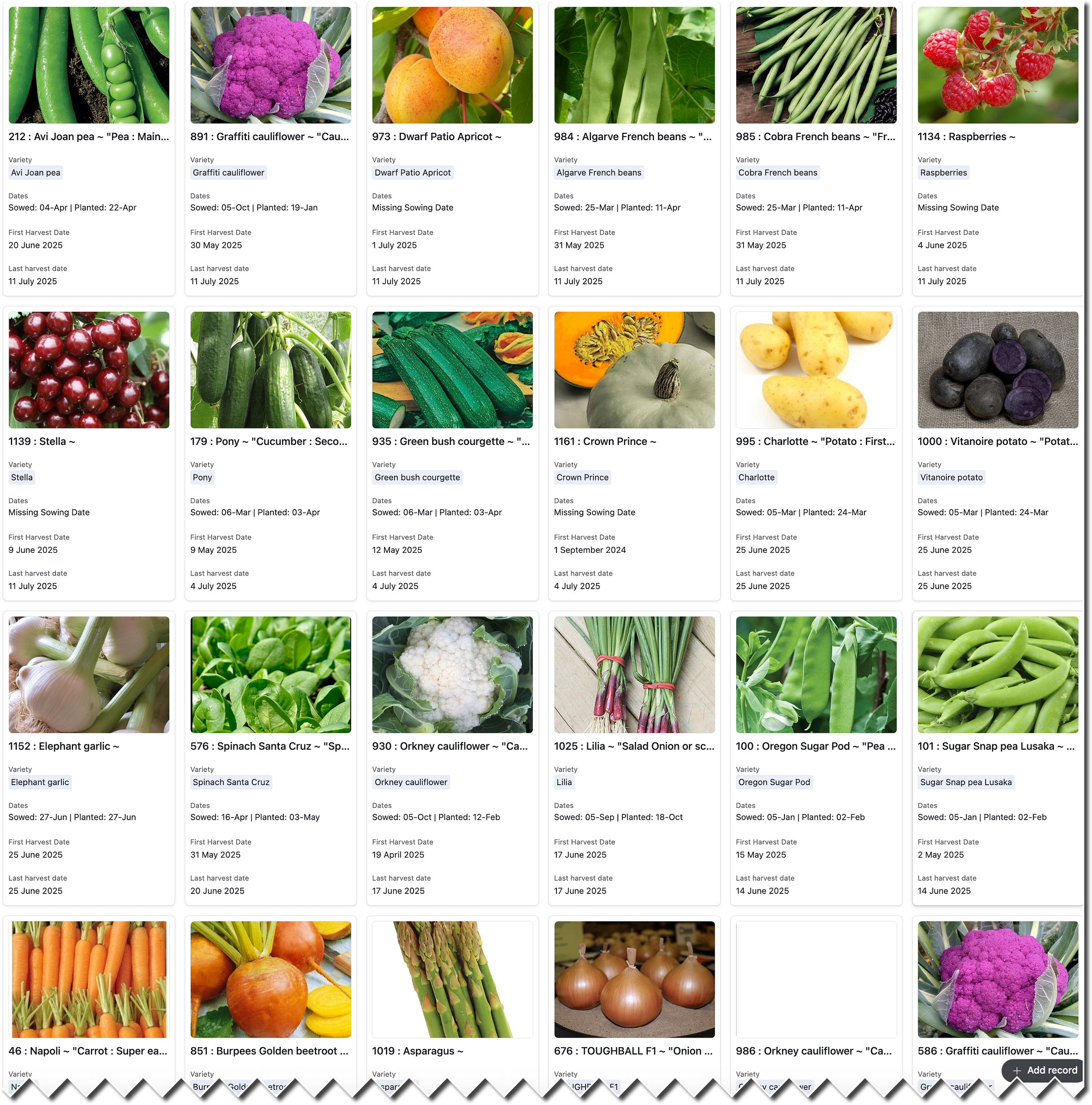






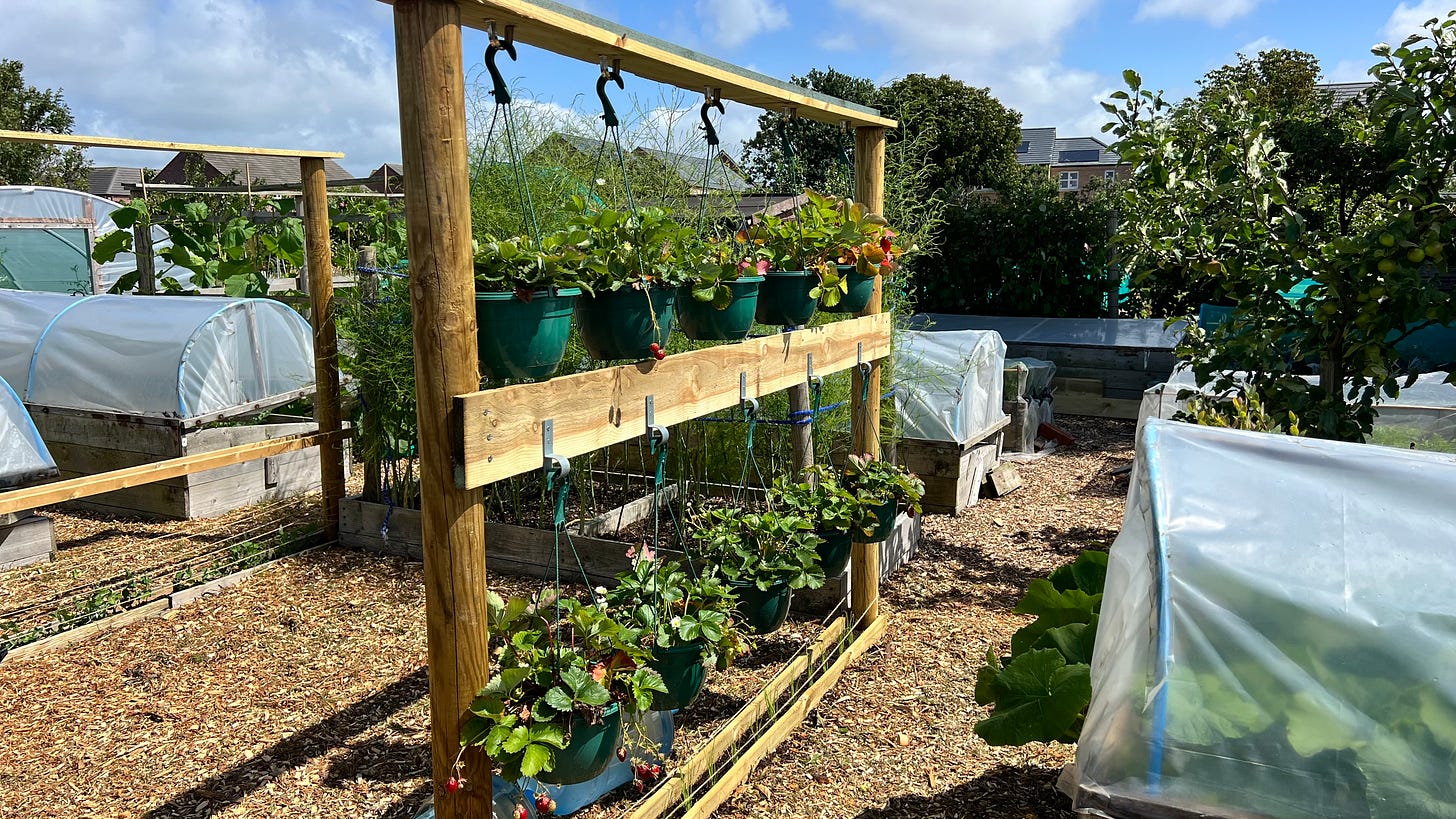

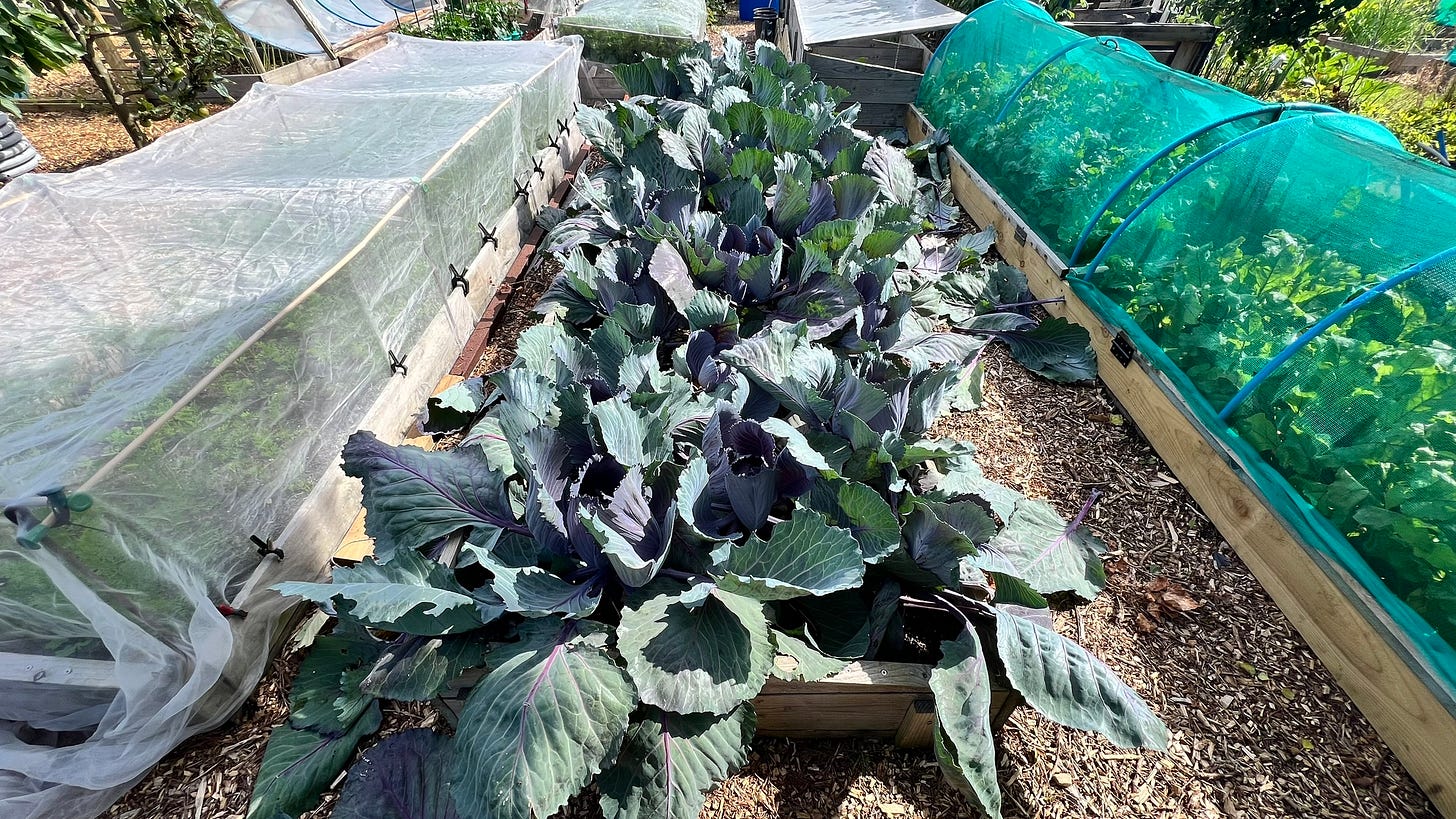
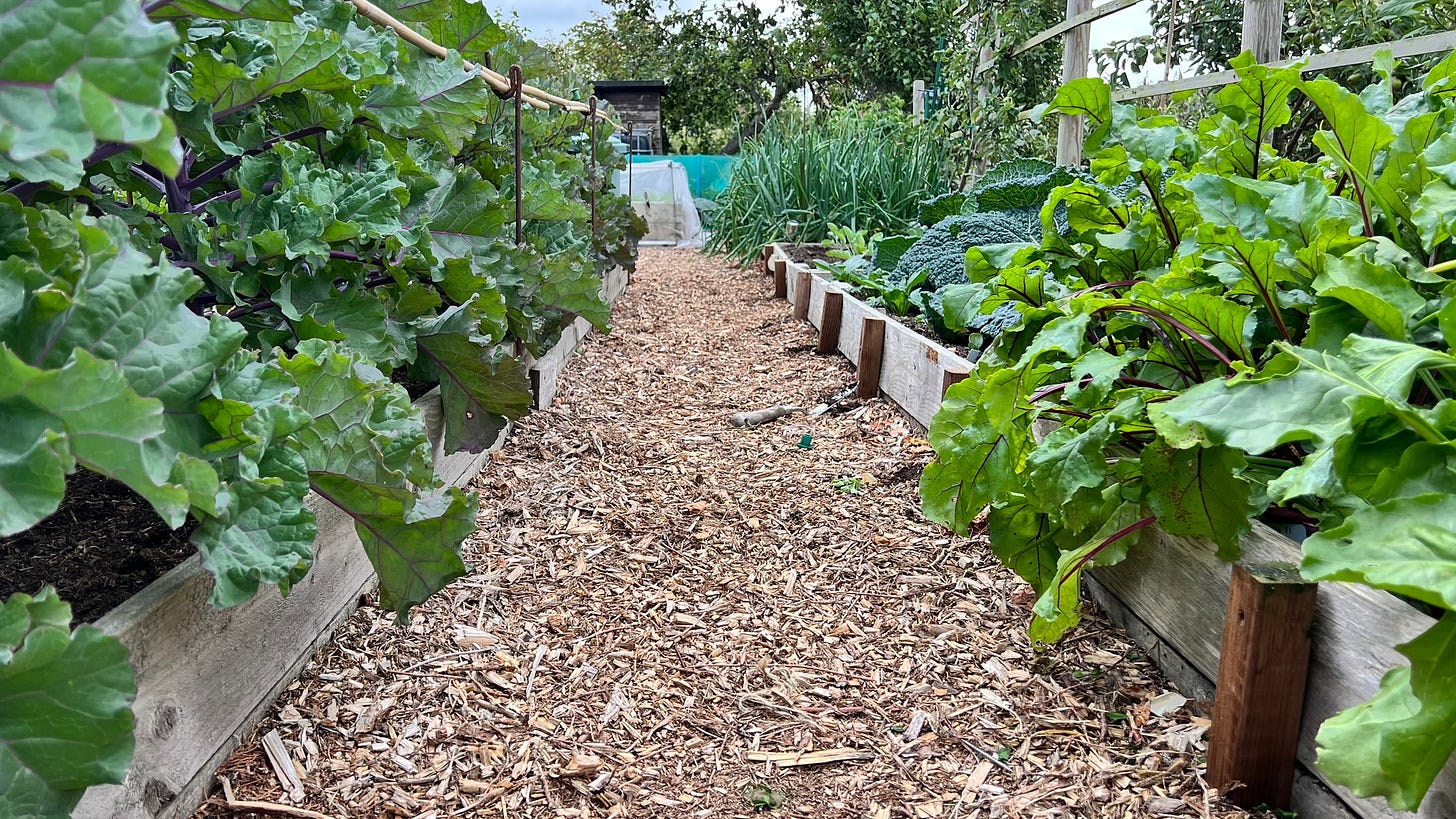


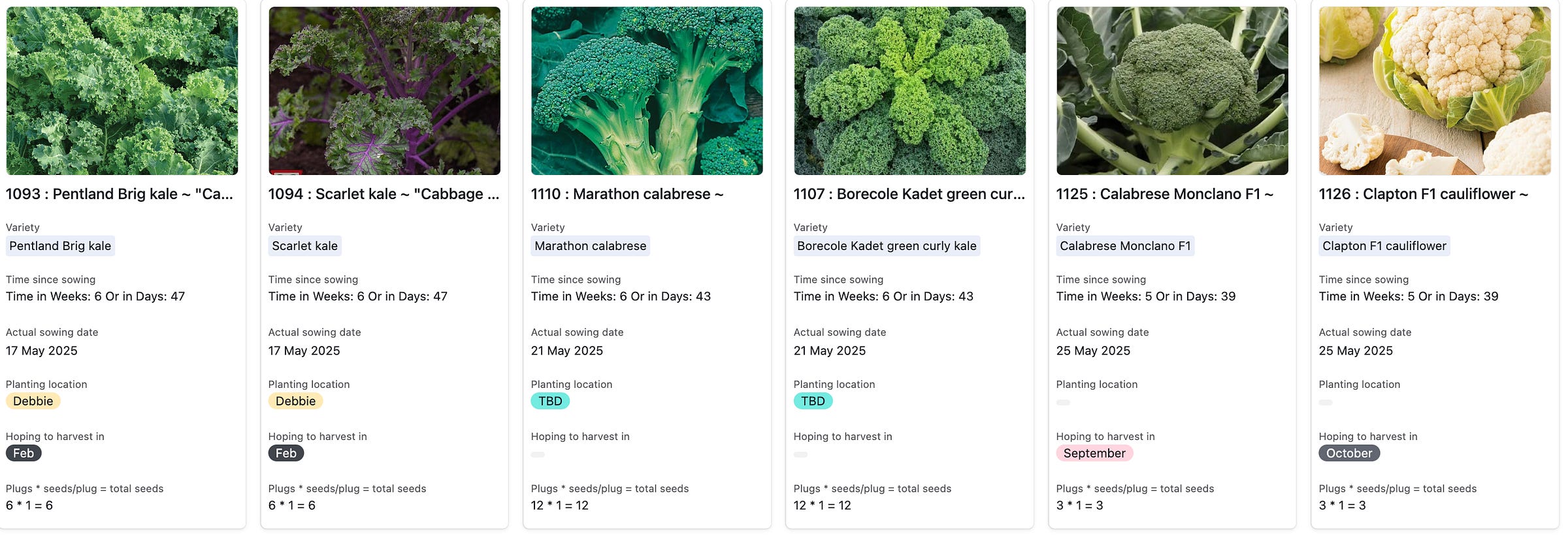
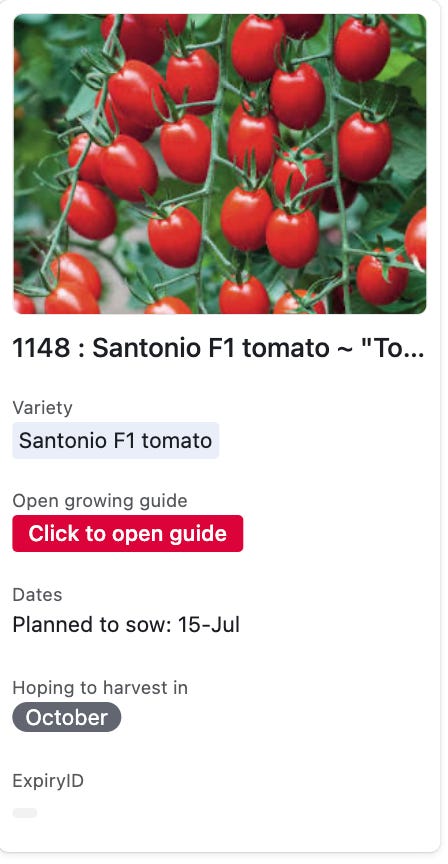




What a great way to start my Saturday, a cup of coffee and your wonderful newsletter Thank you.
I was determined to make it to the open day this year, but its andys 40th that weekend and we're away... sigh. Maybe next year!